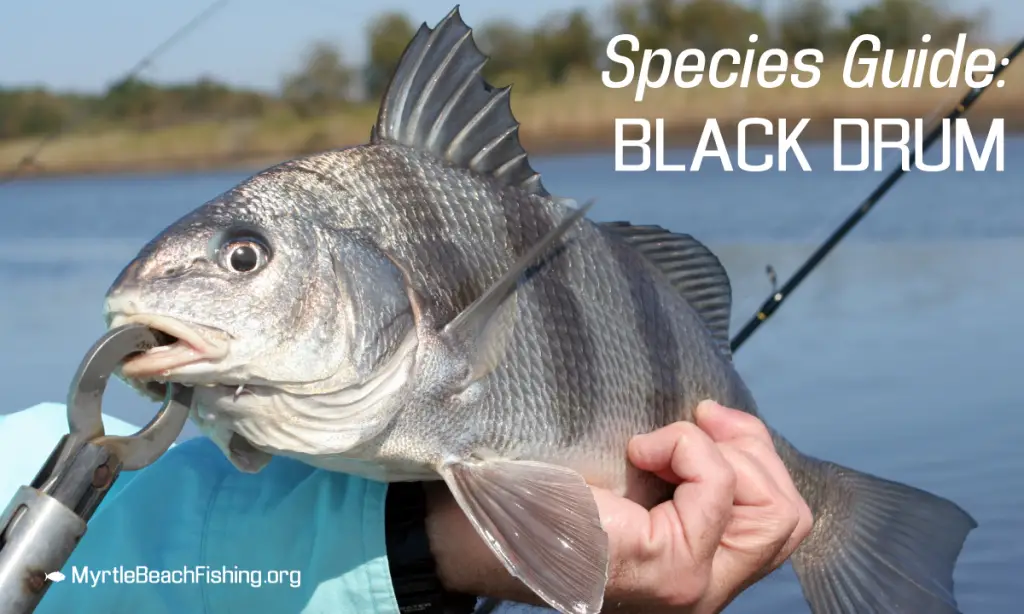
Black Drum is a small to medium size member of the drum family commonly caught in inshore and near shore waters in Myrtle Beach. When Black Drum are younger they have vertical stripes, when they get older they typically lose that marking. While Black Drum can get up to around 100 pounds fully grown that’s not typical for in the Myrtle Beach Area. They have a very powerful jaw that is capable of crushing oysters and other shellfish. The world record black drum was just over 113lbs! It is however required in South Carolina that any Black Drum to keep is a minimum of 14 inches and a maximum of 27 inches. You are also limited to catch only 5 per person per day according to the SCDNR regulations.
How To Catch Black Drum
When in the backwaters trying to catch drum fish you will typically want to use a relatively light tackle. A seven-foot spinning rod is fine to use in most cases with 15lb test line. If you are fishing from a dock or underneath other structres like the Piers in Myrtle Beach, slightly shorter rods can work well. The tackle you would use is like the tackle you would use for most other inshore saltwater species of fish.
The most impactful strategy for fishing from a boat inshore is to select a spot that has a sand-filled bottom structure or oyster bed where baitfish are plentiful at a time during the day with some tidal movement. If you are fishing on a pier or bank fishing you should target the jetties, structure or boat channels near a rapid increase in depth and some tidal movement. We reccomend the Little River Jetties for black drum fishing or along the stone walls in the opening of the Little River Inlet.
Recommended Bait To Catch Black Drum
Natural fresh bait is going to be the best way to catch black drum. Anything from blue crab to clams, in general if it smells bad, it’ll usually work well! A good trick is to break your bait open or pinch it so when you put it in the water that scent will be released so the black drum can smell it easier. Artificial lures can sometimes be a successful way of catching black drum, it just take a little bit of skill to work the bait using short jigging or reeling actions. These fish rely on taste and smell, so the best lure are going to be the soft plastic that are scented with natural flavors like a Gulp! or similar. Using this is similar to live bait, by casting into large schoolings or drifting along the bottom of deep channels and in the back waters.
Local favorite live baits for Myrtle Beach black drum anglers include:
- Live shrimp
- Finger mullet
- Mud minnows
- Pogies
- Small pinfish
Spots To Find Black Drum in Myrtle Beach
You will find these fish in the deep channels inside the inlets, around the time water is warming up in early spring and late fall. They will also make appearances in the fall in the shallow grass areas. In the summer time, when the water turns warm they typically move to deeper water and are harder to catch inshore or off piers. They are commonly found in the muddy bottoms, in the shallows of the Cherry Grove Inlet and the Murrells Inlet areas. Black drum are going to be in the water all year long, however they are hungry during specific times of the year and more timid during other times of the year.
On The Table?
Black drum excellent table fare, they have a moderate flavor and are not oily. They can be very challenging to clean; removing the large scaled from the fish is a tough process. Many fisherman will prefer to fillet with an electric knife at first, removing the fish meat from along the backbone, then using an electric knife to cut the fillet from the skin and scales. The bigger the size of the fish the tougher the consistency will be, sometimes it is compared to chicken, rather than having a flakey texture as many other fish do. The best kind of drum to eat are typically going to be the smaller ones that you catch. Very large drum are sometimes filled with worms — it can be wise to these go and catch them another day!